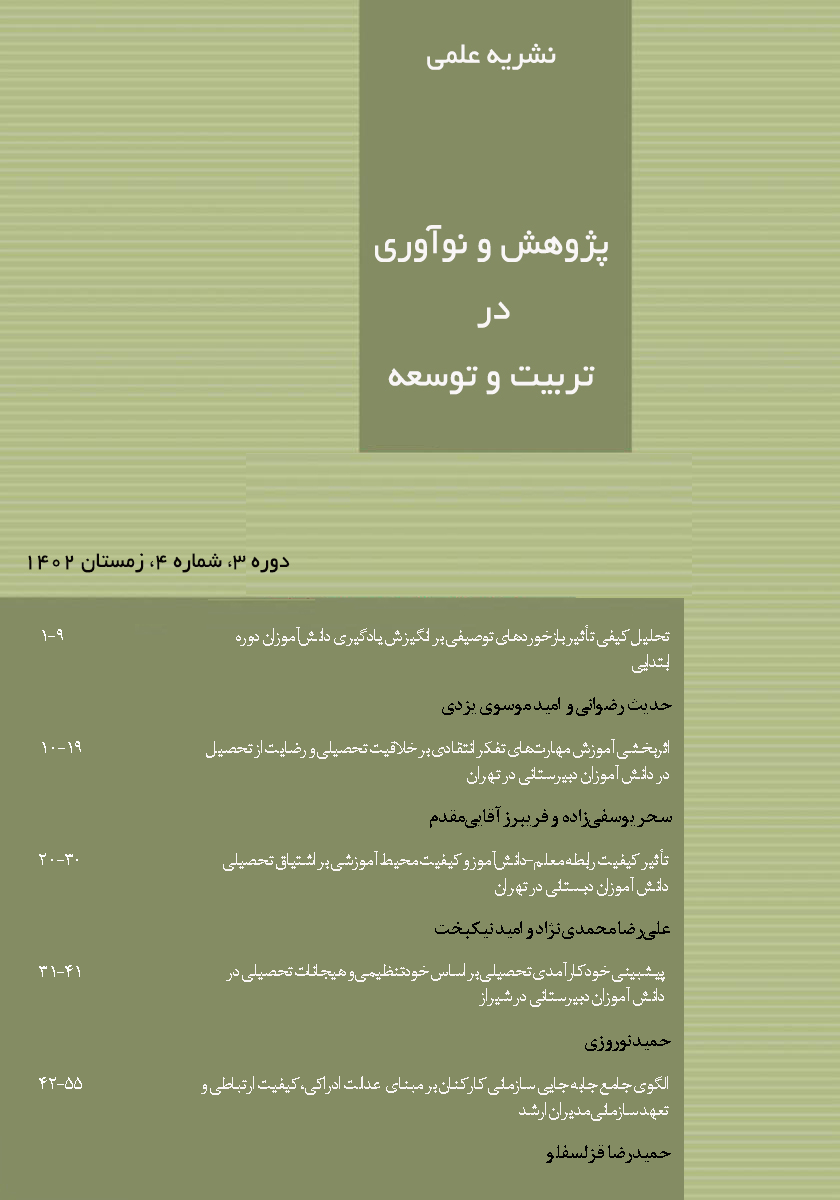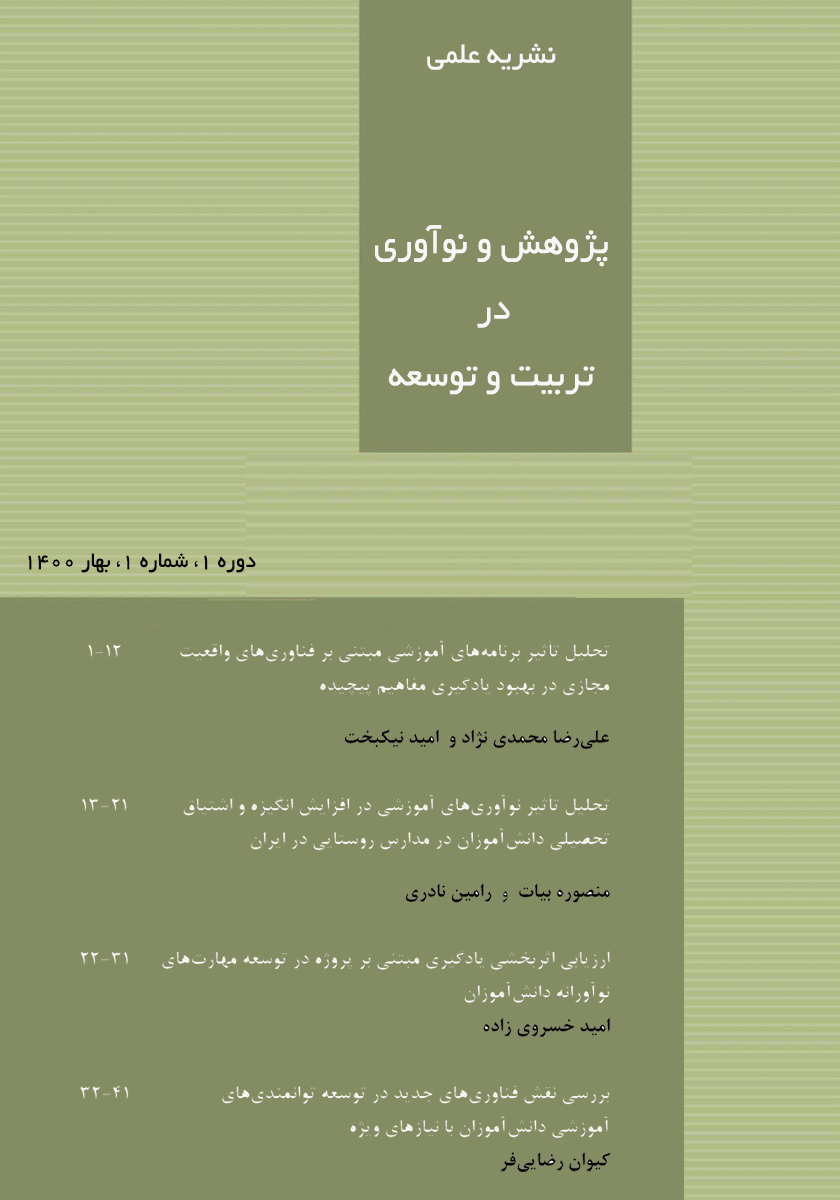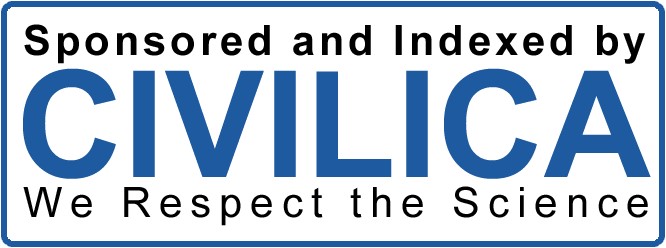A Qualitative Analysis of the Impact of Descriptive Feedback on the Learning Motivation of Elementary Students
Keywords:
Descriptive feedback, learning motivation, elementary education, qualitative research, teacher training, student performanceAbstract
This study aimed to qualitatively analyze the impact of descriptive feedback on the learning motivation of elementary school students. The objective was to explore how descriptive feedback influences students' confidence, interest in learning, academic performance, and social interactions, as well as to identify the challenges teachers face in implementing this feedback effectively. A qualitative research design was employed, utilizing semi-structured interviews to gather data from 19 participants, including teachers and students from elementary schools in Tehran. Participants were selected through purposive sampling, and the number of interviews was determined by theoretical saturation. The data collected were analyzed using qualitative content analysis to identify core themes and categories related to the influence of descriptive feedback. The analysis revealed that descriptive feedback significantly enhances students' learning motivation by boosting their confidence, increasing their interest in learning, improving academic performance, and fostering better social interactions. However, challenges such as limited time for providing detailed feedback and insufficient teacher training were identified as barriers to the effective implementation of descriptive feedback. Descriptive feedback is a powerful tool in enhancing the learning motivation of elementary students. It positively impacts students' confidence, academic performance, and social skills. However, for descriptive feedback to be most effective, teachers require adequate training and sufficient time to provide detailed and meaningful feedback. Addressing these challenges can further optimize the benefits of descriptive feedback in the educational process.
Downloads
References
Adarkwah, M. (2021). The power of assessment feedback in teaching and learning:
a narrative review and synthesis of the literature. SN Social Sciences, 1(3).
https://doi.org/10.1007/s43545-021-00086-w
Aiello, S., Aguayo, C., Wilkinson, N., & Govender, K. (2021). Developing
culturally responsive practice using mixed reality (XR) simulation in paramedicine
education. Pacific Journal of Technology Enhanced Learning, 3(1), 15-16.
https://doi.org/10.24135/pjtel.v3i1.89
Alamsyah, H., Listia, R., & Mu’in, F. (2021). Types of feedback used by the students
in intermediate writing class. Lingua Scientia Jurnal Bahasa, 13(1), 103-123.
https://doi.org/10.21274/ls.2021.13.1.103-123
Algiraigri, A. (2014). Ten tips for receiving feedback effectively in clinical practice.
Medical Education Online, 19(1), 25141. https://doi.org/10.3402/meo.v19.25141
Ali, H. (2023). Students' views of teacher’s feedback in L2 writing class. Dialectical
Literature and Educational Journal, 8(2), 58-62.
https://doi.org/10.51714/dlejpancasakti.v8i2.99.pp.58-62
Bernard, A., Kman, N., & Khandelwal, S. (2011). Feedback in the emergency
medicine clerkship. Western Journal of Emergency Medicine, 12(4), 537-542.
https://doi.org/10.5811/westjem.2010.9.2014
Barton, K., Schofield, S., McAleer, S., & Ajjawi, R. (2016). Translating evidencebased guidelines to improve feedback practices: the interact case study. BMC Medical
Education, 16(1). https://doi.org/10.1186/s12909-016-0562-z
Bing-You, R., Kruithoff, C., Fritsch, S., Trowbridge, R., & Blondeau, W. (2016). A
pilot study of clerkship students’ perceptions of feedback related to their self-reflection
capabilities. Mededpublish, 5, 151. https://doi.org/10.15694/mep.2016.000151
Boghdady, M. & Alijani, A. (2017). Feedback in surgical education. The Surgeon,
(2), 99-103. https://doi.org/10.1016/j.surge.2016.06.006
Bounds, R., Bush, C., Aghera, A., Rodríguez, N., Stansfield, R., & Santen, S. (2013).
Emergency medicine residents’ self‐assessments play a critical role when receiving
feedback. Academic Emergency Medicine, 20(10), 1055-1061.
https://doi.org/10.1111/acem.12231
Brouwers, M., Weel, C., Laan, R., & Weel‐Baumgarten, E. (2018). Training
undergraduates skills in breaking bad news: how students value educators’ feedback.
Journal of Cancer Education, 34(6), 1103-1106. https://doi.org/10.1007/s13187-019-1415-
Buchanan, M., Summerlin‐Long, S., DiBiase, L., Sickbert-Bennett, E., & Weber, D.
(2019). The compliance coach: a bedside observer, auditor, and educator as part of an
infection prevention department's team approach for improving central line care and
reducing central line-associated bloodstream infection risk. American Journal of Infection
Control, 47(1), 109-111. https://doi.org/10.1016/j.ajic.2018.06.005
Molloy, E., & Boud, D. (2013). Feedback models for learning, teaching and
performance. In D. Boud & E. Molloy (Eds.), Feedback in higher and professional
education (pp. 413-424). Routledge. https://doi.org/10.1007/979-1-4614-3185-5_33
Noureen, G. (2013). Effect of descriptive feedback and corrective feedback on
academic achievement of VII graders in mathematics. Pakistan Journal of Education,
Downloads
Published
Submitted
Revised
Accepted
Issue
Section
License

This work is licensed under a Creative Commons Attribution-NonCommercial 4.0 International License.











